Kindred Kingdoms
Flora
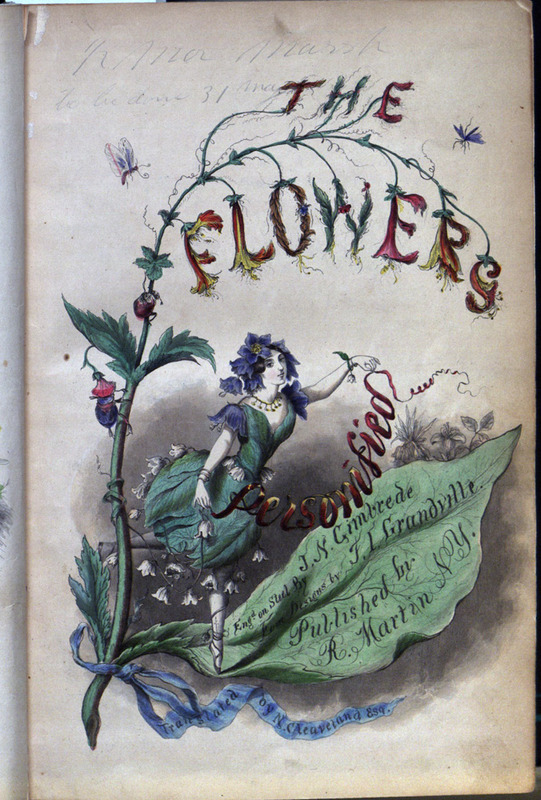
J. J. Grandville (French, 1803-1847)
The Flowers Personified: Being a Translation of Grandville’s Les fleurs animées.
New York: R. Martin, 1847.
Special Collections & Rare Books
MU Libraries
Rare Vault NC1135 .G63 1847
By the mid-nineteenth century the "romantic language of flowers" became a common cultural metaphor. Plants as gifts, herbaria and botanical illustrations became customary. Professor Theresa M. Kelley, one of theClaiming Kin symposium's participants and an author of Clandestine Marriage: Botany and Romantic Culture, applies Linnaeus's termCryptogamia, which designates a class of plants whose reproductive parts are hidden from view, to describe the role of botany as both a "scientific inquiry and a critical component" of the contemporary notion of "the kingdoms of nature, including the human."
The focal point in this case is given to The Flowers Personified, an English translation of Fleurs animées by Jean Gérard, a French caricaturist, known by his nom-de guerre J.J. Grandville, published in 1847. Each print in this book is beautifully hand-colored and represents one or two flowers personified by exquisite young belles. The book was considered a masterpiece of botanical illustration.
J. J. Grandville, born Jean-Ignace-Isidore Gérard, made his reputation as a cartoonist and book illustrator during the second quarter of the nineteenth century. Grandville's book illustrations feature elements of the symbolic, dreamlike and incongruous, sometimes even verging on the surreal. His art often blends human features with the characteristics of animals or inanimate objects in order to make a satirical or political point.
In each hand-colored steel engraving, Grandville characterizes his doll-like ladies with features, dress, and occupations typical of each flower.
Logical predecessors to The Flowers Personified are the books that belong to the genre known as "herbals", some of which we exhibit here. The word "herbal" didn't come into common usage until the beginning of the sixteenth century, but works describing plants and their medical, magical, and culinary possibilities had been among the earliest books in ancient Egypt, Greece, and Rome. The first surviving herbal was written about 65 AD by Pedanios Dioscorides and was entitled De materia medica. Herbals are such rich repositories of learning, history, and exploration that they were a great source of inspiration for artists.
Gallery
Click the images below for more details.
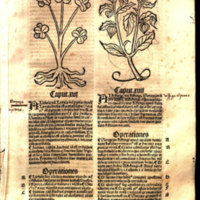
Hortus sanitatis.
Strassburg: R. Beck, 1517.
Special Collections & Rare Books
MU Libraries
Rare Vault QH41 .H6
Hortus Sanitatis, the garden of health, is based on the tradition of medieval herbals, or books of medicinal plants. Though anonymous, its compilation is widely attributed to Jacob Meydenbach of Mainz. Like most medieval texts of this kind, it is a compilation of earlier authorities on the subject, including Dioscorides, Albertus Magnus, Pliny, and others. The illustrations of plants in this work are based on traditional representations, not necessarily on nature. It is innovative, however, in that it finds remedies not only in the plant kingdom, but in animal. The Caladarius, for example, is a gleaming white bird whose gaze will instantly heal a sick man.
This book, one of the most popular and influential of the fifteenth century, was quickly superseded by the newer, more scientific herbals compiled by physicians such as Leonhart Fuchs in the sixteenth century.
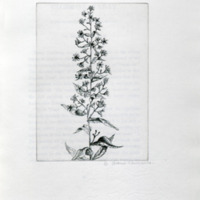
Thomas Fassam
An Herbarium for the Fair.
London: Hand & Flower Press, 1949.
Special Collections & Rare Books
MU Libraries
Rare QK99.A1 F3
Fassam urges the reader to "open their hearts and mind to a plant." By "gazing with love and longing at a plant, its spirit may enter and by being enveloped permeate the spirit with the special balm or cordial belonging to the plant's peculiar family and sort."
With information extracted from old herbals, each plate is accompanied by a summary of the principal properties and lore concerning each herb. Among these are Darnel to afflict a person's dreams and Golden Rod (displayed) to sweeten the mouth.
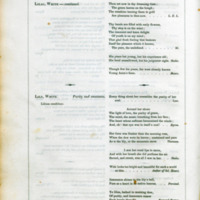
Elizabeth Washington Wirt (American, 1784-1857)
Flora's Dictionary.
Baltimore: Published by Fielding Lucas, Jun., 1835.
Special Collections & Rare Books
MU Libraries
Rare QK83 .W5 1835
Based on an Elizabeth Wirt manuscript, Flora's Dictionary contains quotations and poetry that complement blossom and plant descriptions. Each entry includes the human emotion or experience that is symbolized by each flower and plant. As seen in the displayed page, a white Lily represents purity and sweetness, while a yellow Lily represents falsehood.
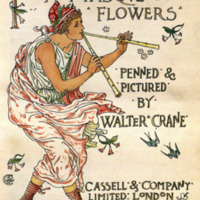
Walter Crane (British, 1845-1915)
Flora's Feast: A Masqve of Flowers.
London; New York [etc.]: Cassell & Company Limited, 1899.
Special Collections & Rare Books
MU Libraries
Rare NC1115 .C78 1899
In this children's poem, Walter Crane pens and illustrates the verse with art nouveau imagery of humans dressed as flowers. This celebration of flowers through the seasons depicts the joy people experience as new flora emerges.
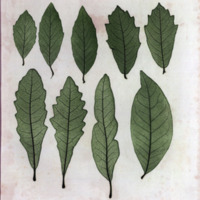
Alois Auer, Ritter von Welsbach (Austrian, 1813-1869)
Die Entdeckung des Naturselbstdruckes.
Wien: K.K. Hof- und Staatsdruckerei, 1854.
Special Collections & Rare Books
MU Libraries
Rare Folio Z259 .A9
Since Gutenberg's invention no more important discovery has been made in the art of printing... [O]ur natural self-acting printing-process will call forth a new era in the publication and figurative representation of artistical-scientific objects.
Alois Auer was director of the Viennese Hof- und Staatsdruckerei (Majesty's Stationery Office,) where he was responsible for several innovations in lithography and printing technology. Most notable for our purposes is his development of a technology of illustrating printed books that did not rely on woodcuts or engravings. It had the potential to produce more detailed and accurate illustrations at less cost. He describes this process, which he labels "the natural self-acting printing-process," in Die Entdeckung des Naturselbstruckes (Discovery of the Natural Printing Process: An Invention). Its introduction is an endearingly confident document, so important that he has obligingly translated it into four languages. He describes impressing natural objects, such as plants and flowers, into soft lead, from which prints could be obtained. He describes experimenting first with lace, and how when presented with the results, an assembly mistook them for the original objects. His method had the advantage of capturing details of texture that engraving could not match. It was patented on October 12th, 1853.
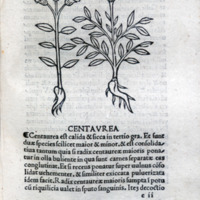
Arnaldus de Villanova (Catalan, c. 1235-1311)
Herbolarium de uirtutibus herbarum.
Venetiis: Impressum per Ioannem Rubeum & Bernardinu fratres Vercellenses, Anno Domini MDVIIII die XV Marcii, 1509.
Special Collections & Rare Books
MU Libraries
Rare QK41 .H4 1509
Lapis lazuli… is effective against ailments of the heart if given with the juice of borage and the bone from the heart of a deer. And as it may be said briefly, it is effective against all the sufferings of melancholy.
This is an Italian edition of the Herbarius Latinus, which was first published in 1484 by Peter Schoeffer, an associate of Gutenburg. The Herbarius Latinus is an anonymous compilation of classical and Arabic sources, some of which have conflicting advice on the herbs described. It contains 150 woodcuts, more than any other of its day. Our Italian edition attributes authorship to Arnaldus de Villanova, a 14th-century physician, alchemist, and translator. According to Frank Anderson, author of An Illustrated History of Herbals, this was because a 1491 edition had featured a frontispiece of Villanova and Avicenna. Villanova's name remained after the frontispiece was eliminated, leading later printers basing their copy on that edition to the mistaken belief that he was the author.
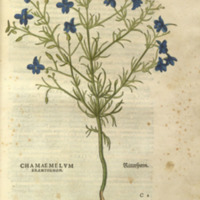
Basileae: In officina Isingriniana, 1542.
Special Collections & Rare Books
MU Libraries
Rare Vault QK41 .F7
Leonhart Fuchs was a German physician and naturalist who is sometimes credited as being a founder of botany. In this hand-tinted edition of De Historia Stirpium Commentarii Insignes from 1543, he describes and provides illustrations for about 500 wild and domestic plants from the new world as well as the old. He desired to identify, describe, and illustrate the plants mentioned by ancient authors such as Galen, Hippocrates, Pliny, and especially Dioscorides, author of the early pharmacy manual, De Materia Medica. He did not simply reproduce these revered predecessors, however, but created text and illustration based on observation. He further departed from classical tradition by adding over a hundred that had not appeared in earlier works, including maize, tobacco and other newcomers to the European landscape.
Fuchs was no taxonomist; rather than grouping plants by class, he arranged them in alphabetical order according to the Greek alphabet, making his work unwieldy as a reference work by our standards. By including plants that had no known medical use and were unknown to the ancient authorities, Fuchs contributed not only to medical pharmacology but to general botany and plant morphology. His work continued to be influential into the seventeenth-century. The woodcuts, by engraver, Veit Rudolph Speckle, have been widely admired for their graceful and sensitive handling. Most late sixteen-century herbals copy them directly, along with his textual descriptions.
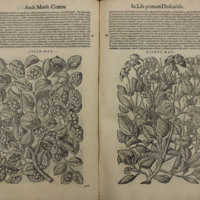
Pietro Andrea Mattioli (Italian, 1500-1577).
Commentarii, in sex libros Pedacii Dioscoridis Anazarbei, De medica materia.
Venetijs: apud Felicem Valgrisium, 1583.
Special Collections & Rare Books
MU Libraries
Rare Vault R126.D6 M3 1583
In his Commentarii, Mattioli annotates the work of Dioscorides (fl. 60 A.D.), whose De materia medica remained the standard herbal throughout Europe for 1500 years. Mattioli's work as a scholar and physician earned him a reputation; in 1555, the Holy Roman Emperor, Ferdinand I, invited him to the Imperial Court to treat his son Maximilian. Mattioli remained there for twenty years.
During his lifetime, he was also known for his absolute intolerance of rival viewpoints. His preface, running fourteen folios, records his displeasure. Despite his occupation as a physician, Pietro Mattioli's work marks a shift from studying plants for medicine's sake to studying them for their own. He elaborated Discorides' original descriptions well beyond their medicinal properties. He also added descriptions of plants not known to Discorides, including an early variety of tomatoes growing in Europe.
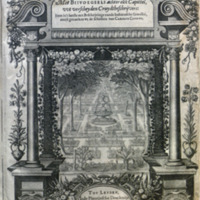
Rembert Dodoens (Flemish, 1517-1585)
Cruydt-Boeck.
Tot Leyden: Inde plantijnsche druckerije van Françoys van Ravelingen, 1618.
Special Collections & Rare Books
MU Libraries
Rare Folio QK41 .D62 1618
Rembert Dodoens was a Flemish botanist and physician, who became the personal physician to Holy Roman Emperor Maximilian II, as Pietro Mattioli had been. He remained in that post following the accession of Rudolph II. His Cruydt-Boeck was well known; some scholars believe that Shakespeare's botanical knowledge came from Henry Lyte's English translation
In the Cruydt-Boeck , Dodoens he provides information about each plants' geographical range, season, the origin of its name, a description of its nature, and finally its virtue. The first three categories are self-explanatory; a plant's "nature" is based on the ancient theory of five elements, according to which all matter was composed of a unique combination of earth, air, fire, water, and aether, each of which possesses varying degrees of heat or dryness. Dodoens lists a plant's medicinal properties in the "virtues" section. Among the many virtues of the Southernwood are the following, in Lyte's English translation, mentioned above:
The seede of Sothrenwood either greene or drie made into power, or boyled in water or wine, and drunken is very good and greatly helpeth such as are troubled with shortnesse of winde, and fetching of breath, by meanes of any obstruction or stopping about the breast, and is good against the hardnesse and bursting and shrinking of sinewws.
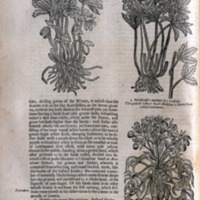
John Parkinson (British, 1567-1650)
Theatrum Botanicum: The Theater of Plants, or An Herball of Large Extent.
London: Tho. Cotes. 1640.
Special Collections & Rare Books
MU Libraries
Rare Folio QK41 .P2
This "Manlike Worke of Herbes and Plants," as Parkinson called it, was a summa of the preceding centuries of European botany. These 1755 folio pages contain much gleaned from his predecessors, but Parkinson also included new material of his own. For example, he was the first to record the Lady's Slipper and the Strawberry Tree. The Theatrum reflects the increasing importance in the genre of botany —the discovery, documentation, and classification all known plant life— over medicine. Despite these advances, however, he includes legendary species such as the Vegetable Lamb, a plant believed to be home to a tiny lamb that produced the most delicate wool imaginable. Parkinson divides all plant life into sixteen groups that may seem whimsical to modern taxonomists; examples include, "Sweet Smelling Herbes," "Strange and Outlandish Plants," and "Venemous, Sleepy, and Hurtfull Plants." According to Frank J. Anderson, "the Theatrum marked a glorious sunset on the age of herbals, and it left a glow that will last as long as the English language is read."

Sir John Colbatch (British, 1670-1729)
A Dissertation Concerning Misletoe.
London: Printed for Dan. Browne, Jun. ..., 1725.
Special Collections & Rare Books
MU Libraries
Rare QK495.L87 C6 1725
Sir John Colbatch was an English physician and apothecary most concerned with finding new remedies for human illnesses and other maladies. His book on finding medicinal properties for mistletoe as a cure for convulsive distempers has never been proven. Although using mistletoe for treating circulatory and respiratory problems is popular in Germany, modern clinical tests have never found medicinal benefits in mistletoe.

Pliny the Elder (Roman, 23-79 ce)
Naturalis historia.
Coloniae: In aedibus Eucharii Cervicorni, 1524.
Special Collections & Rare Books
MU Libraries
Rare PA6611 .A2 1524
Roman historian and natural philosopher Pliny the Elder was one of the best known people to die during the 79 CE eruption of Mt. Vesuvius. His only surviving work, Naturalis Historia, was published between 77 and 79 CE. This encyclopedic work focused on various topics including mineralogy, metallurgy, botany, zoology, and art history. In chapter 5 of Book 12, devoted to the plane tree, Pliny tells the anecdote of Emperor Caius who built a dining room within the branches of this remarkable tree.
By means of broad benches loosely laid from branch to branch... [He] held a banquet in it — himself adding very materially to the shade it threw — the triclinium being formed for the reception of fifteen guests and the necessary attendants: to this singular dining-room he gave the name of his "nest."
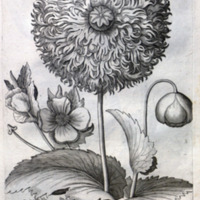
Johann Theodor de Bry (German, 1561-1623?)
Florilegium renovatum et auctum, das ist, Vernewertes und vermehrtes Blumenbuch
Franckfurt am Mayn: Bey Matthaeo Merian Buchhändlern, 1641.
Special Collections & Rare Books
MU Libraries
Rare Vault QK41 .B7 1641
J. T. de Bry's Florilegium novum was originally published in 1612. He derived much of it from the work of his contemporaries, including de Passe and Vallet. Nonetheless, a supplement was issued in 1614, which contained original drawings of North American plants. It was so popular that de Bry's son-in-law, engraver Matthaeus Merian, published an expanded edition in 1641. The Florliegium renovatum et actum doubled the number of woodcuts and included six folding plates.
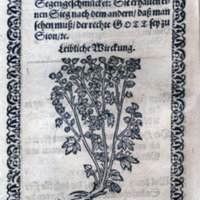
Conrad Rosbach
Newes Paradeisz Gärtlein.
Franckfurt: J. Bringer, 1613.
Special Collections & Rare Books
MU Libraries
Rare QK 41 .R6 1613
Rosbach's tome lists in German the best and most noble of seeds one can have for one's herb garden. Throughout the book, Rosbach frequently quotes verses from the Bible referring to plants and trees. Beautifully detailed woodcuts of various plants are included throughout.
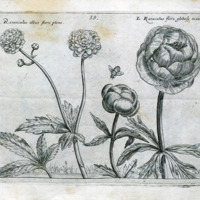
Crispijn van de Passe (Dutch, d. 1670)
Hortus floridus in quo rariorum & minus vulgarium florum icones ad vivam varamq[ue] formam accuratissime delineatae.
Extant Arnheimij: apud Ioannem Ianssonium, bibliopolam ibid. [1614-1616]
Special Collections & Rare Books
MU Libraries
Rare QK41 .P3 1614A
Crispijn van de Passe's Hortus Floridus is considered the last of the golden age of illustrated herbals. Strictly speaking, it is a florilegium rather than an herbal. As such, it showcases the beauty of the plants it depicts, rather than their medicinal use. It thus caters to a less specialized audience than the more scientific herbal. Sacheverell Sitwell suggests that the Hortus Floridus was intended for a larger public, "to be looked at perhaps, on winter evenings with snow outside and in the flickering lighting of early seventeenth century rooms, with summer still far away."
According to Agnes Arber, author of Herbals: Their Origin and Evolution, Crispijn van de Passe's florilegium contains finer copper-plate figures of plants than any of its predecessors or contemporaries. They are pictured from a ground-level perspective characteristic of the Dutch style. The illustrations were intended to be colored in by the purchaser. De Passe evidently worried that many copies would be left uncolored, for the text intersperses words of encouragement to the colorist to finish up the task. In Hortus Floridus the flowers are arranged by seasons, and special attention is given to tulips, as the book was printed at the height of the tulip craze.
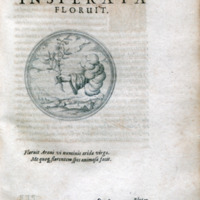
Joachim Camerarius (German, 1534-1598)
Symbolorvm & emblematvm: ex re herbaria desvmtorvm.
Francofvrti: Impensis Iohannis Ammony, 1654.
Special Collections & Rare Books
MU Libraries
Rare NE1683 .C35 1654
Camerarius was a physician and botanist whose works feature what are arguably the most sophisticated representations of plant life from the golden age of herbals. The enlarged scale of the woodcuts reveals plant structure in more detail. They show an interest in the lifecycle, often placing the seedling and adult plant side by side. Camerarius's Symbolorum & emblematum reproduces and explains emblems that incorporate plant symbols. It was the first of a four-part series of emblem books.
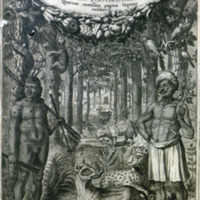
Willem Piso (Dutch, 1611-1678)
De Indiae utriusque re naturali et medica libri quatuordecim.
Amstelaedami [Amsterdam, Netherlands]: Apud L. et D. Elzevirios, a1658.
Special Collections & Rare Books
MU Libraries
Rare Folio QH183 .P67
Historia Naturalis Brasiliae is the earliest work on the subject of Brazilian natural history. Willem Piso served as an expedition doctor in Brazil from 1637 to 1644. During this time, Piso, along with his colleague Georg Markgraf, wrote Historia Naturalis Brasiliae. Piso contributed the four books collectively entitled De medicina Brasiliense, in which he describes diseases and their native remedies. The remainder of the work is devoted to Markgraf's observations of native flora and fauna.
Noting the absence of many common European afflictions among the native population, he attributed the discrepancy to the superior nutrition of native Brazilians; he was thus an early proponent of using diet as a means of preventative health care. Containing over 400 woodcuts, the Historia remained the authoritative source of Brazilian natural history until the nineteenth century.
Following his return to the Netherlands from Brazil in 1655, Willem Piso published a second edition of the Historia naturalis Brasiliae. Though the first edition had been the results of a collaborative effort between Piso and Georg Markgraf, Piso neglected to acknowledge the latter's contribution.
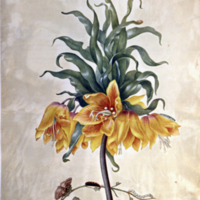
Maria Sibylla Merian (German, 1647-1717)
Leningrad Watercolours.
New York: Harcourt Brace Jovanovich, c1974.
Special Collections & Rare Books
MU Libraries
Rare Folio QH31.M4516 A34 1974A
Maria Sibylla Merian was the grand-daughter of Theodor de Bry and daughter of Matthaeo Merian, whose jointly produced Florilegium renovatum continued to be in popular demand. From them she inherited an interest in the natural world and the artistic ability to render it on paper. She also inherited their intense Calvinism, and may have even surpassed them. She spent part of her adult life in a Pietist colony in Frisia. There she heard reports of marvelous flora and fauna from another such colony in Suriname, enticing her to set out for South America to see it for herself.
Despite success in her own day, Merian's work for a long time languished under the misnomer "minor art.' It has recently come into its own, with exhibitions in Los Angeles and Amsterdam. Ingrid Rowland, who compares Merian's work to Carvaggio's, notes her "crystalline accuracy, " "incomparable precision," and the "electric intensity" of her color. She asserts, "there is no question that she was an artist. Her disquieting view of life in all its forms has carefully, cleverly shaped every one of the images that seem, so deceptively, to present intimate, dispassionate snapshots of reality."
Peter the Great became a collector of her work. As a result some of her work remains in the Russian Academy of Sciences in St. Petersburg. The Leningrad Watercolours collects 50 of facsimiles of the work housed there.